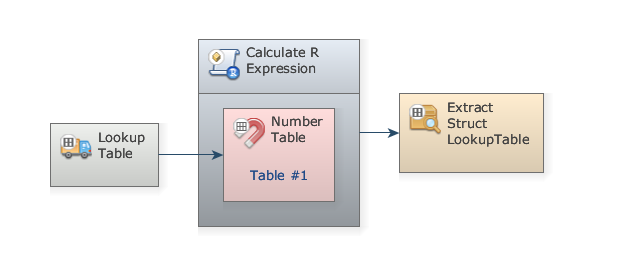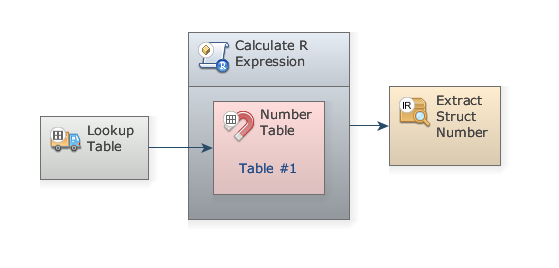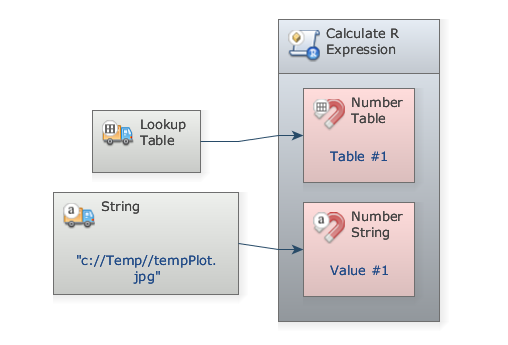Table of Contents
Calculate R Expression
Description
The functor 'Calculate R Expression' allows Dinamica EGO to call R externally and process the script outputs as if they were part of Dinamica itself. For an overview of how Dinamica and R can be linked together check the documentation about R Coupling.
Inputs
| Name | Type | Description |
|---|---|---|
| Expression | String Type | The expression that will run on R. |
| Treat Warning As Errors | Boolean Value Type | Warnings on R script will be considered errors. |
Optional Inputs
None.
Output
| Name | Type | Description |
|---|---|---|
| result | Struct Type | A struct containing the output values generated by the expression. |
Group
Notes
There are two ways to setup the 'Calculate R Expression' functor:
Dinamica EGO Enhancement Plugin
Simply download and install the Dinamica EGO Enhancement Plugin. It contains everything you need to run R scripts inside Dinamica EGO.
Local R Installation
Additionally, users can specify and use their own local R installation for execution. The pre-requisites are:
- R needs to be at least at the 3.3.1 version.
Rscript.exemust be valid and located at the<installation folder>/binsub-folder.
- Dinamica package for R must be installed and at the latest version.
To specify your custom R installation, go to Tools –> Options –> Integration tab and select Use alternative R installation for Calculate R Expression:

Usage
The functor is available under the Integration tab at the library.
R Script Inputs
To pass input parameters from Dinamica EGO to R, hooks must be placed to collect data. You can use the Create a hook button on the selected functor bar or drag the hooks individually. The valid hook types are:
To access the passed inputs on your R script, follow Dinamica EGO naming conventions and use t[0-99], v[0-99], s[0-99] for each type respectively. For example:
# Will store the 5th key from the passed Lookup Table in the variable 'testing' testing <- t1$Keys[ 5 ]; # Store the second passed String. secondString <- s2; # Store the 10th passed Value. tempNumber <- v10;
R Script Outputs
To output data back to Dinamica EGO, the user must call a set of functions designed for this functionality:
| Function name | Output Data Type | Usage Example |
|---|---|---|
| outputDouble() | Real | outputDouble( “myDouble”, 3.14 ) |
| outputNumberVector() | Tuple | outputNumberVector( “myTuple”, c(1:10) ) |
| outputString() | String | outputString( “myString”, “This is a string” ) |
| outputLookupTable() | LookupTable | outputLookupTable( “myLUT”, c(1:10), c(1:10) * 10 ) |
| outputTable() | Table | outputTable( “myTable”, data.frame(State = c(“Massachusetts”, “Massachusetts”), City = c(“Boston”, “Chelsea”), Population = c(667137, 39398), stringsAsFactors = FALSE), 2 ) |
In the examples above, data was constructed inside the calling functions. You can also specify variables as parameters.
Keep in mind:
- You can pass any kind of numeric value on the
outputDoublefunction.
- Collections of numbers are valid number vector's.
- A Lookup Table requires 2 number vectors, one for the “Key” and another for the “Value”. Both vectors must have the same number of elements.
- The
outputTablefunction requires a table, that can be constructed with data.frame R function. There is another parameter that is optional with default value 1, and it means how many Key columns the table has, from the leftmost column.
Tables / Lookup Tables
Tables or Lookup Tables can be transferred to R using the Number Table functor. When dealing with each of these types extra caution must be taken:
Lookup Tables
Lookup Tables are transferred to R as a List with two columns, “Key” and “Value”.
Each column can be individually accessed by using the $ operator, for example:
t1$Key[ 1 ]will access the first key of the Lookup Tablet1.
t2$Value[ 2 ]will access the second value of the Lookup Tablet2
Tables
Tables are transferred to R as a DataFrame type variable. Each column can be individually accessed by using the $ operator, just like Lookup Tables. Please check this page for more information on how to deal with Tables. The rules for them in Calculate R Expression are the same as sending and receiving through External Communication.
Example Scripts
Multiply each value of the passed Lookup Table by itself

Expression:
for ( i in 1:length( t1$Value ) ) { tempValue <- t1$Value[ i ]; t1$Value[ i ] = tempValue * tempValue; } outputLookupTable( "poweredTable", t1$Key, t1$Value );
Extract the mean of passed Lookup Table values

Expression:
tableMean <- mean( t1$Value ); print( paste( "Mean is", tableMean ) ); outputDouble( "mean", tableMean );
Noticed the print() statement? Dinamica EGO's Message Log will show output messages from the R script (as Result's).
Plot passed Lookup Table to an image on the path specified by passed String

Expression:
outputFile <- s1; print( paste( "Plotting to", outputFile ) ); jpeg( outputFile, quality=100 ); plot( t1 ); dev.off();
Internal Name
CalculateRExpression